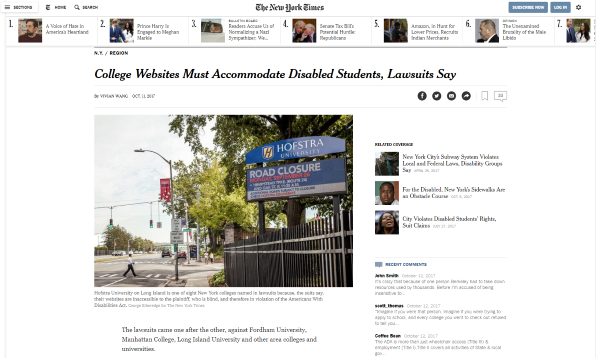A New York Times Article explores the risk inaccessible websites pose to colleges - is this an opportunity for web professionals to increase the resources allocated to properly manage digital channels ?
By now everybody working in Higher Education web and digital teams should know about the importance of having a highly accessible website. Since the start of 2017 a number of organizations, from legal firms to accessibility advocacy groups have been taking legal cases against Colleges and Universities across the US. What took us by surprise is that this topic is now making waves in US national media.
A New York Times article published on October 11th 2017 delved into how eight lawsuits are being taken against colleges whose websites aren’t accessible for disabled students. In total eight lawsuits had been filed in federal court in Manhattan during the previous two weeks. In each case, lawyers for the plaintiff, who is blind, charged that the websites are inaccessible to the plaintiff and therefore in violation of the Americans with disabilities Act.
In recent times, there has been a sizeable increase in the number of actions being taken around accessibility and the internet. The same New York Times article reports that since January 2015, at least 751 lawsuits have been filed over this issue.
We’re all familiar with laws requiring public spaces to be accessible to those with disabilities. Lawyers and advocates are now arguing that the same laws should apply to websites. After all, websites are public places and therefore need to be accessible to all.
The background: ADA and Section 508 for higher education
In the United States, educational institutions are required to comply with the Americans with Disabilities Act (ADA). This includes making provisions for web accessibility.
Section 508 ( https://www.section508.gov/content/learn ), part of the Rehabilitation Act, outlines online accessibility standards that federal agencies, contractors and employers must meet. Although Section 508 does not currently directly apply to private sector companies and educational institutions, many colleges and universities have taken the initiative to make their site accessible.
Why is accessibility so important in web design?
In simple terms an accessible site is one that can be used by people with disabilities. The Web Accessibility Initiative describes accessibility as meaning that: “People with disabilities can perceive, understand, navigate, and interact with the Web, and that they can contribute to the Web...Web accessibility encompasses all disabilities that affect access to the Web, including visual, auditory, physical, speech, cognitive, and neurological disabilities.”
Web accessibility is beneficial to all website users not just those with disabilities. One of the key principles of accessibility is to design websites with flexibility in mind. An accessible website is one that adapts to meet different user's needs, preferences and situations. This means that a website will take into account people’s changing circumstances; perhaps they are accessing your site with a slow internet connection, have a temporary issue with their vision or have a broken arm.
Another benefit of having an acessible website is that it has a very positive impact on search engine optimization, as search engines interact with your website as though they are blind.
Why is web accessibility so important for college websites?
The U.S. Department of Education reports that 11 percent of undergraduates have a disability.

We have discussed the issue of web accessibility and higher education on the blog previously – Accessibility Standards Higher Ed can't ignore. In this post we go into detail on the accessibility basics you need to apply to your website including ALT tags, page structure and form building.
Web & digital teams: How can you use this legal situation to your advantage (as a web professional)?
The recent legal cases against Universities and Colleges are a way for you to raise the profile of digital standards within your organization. The risks in this area can open funding and budget from buckets not usually accessible to you. Use these legal challenges as a way to grow the resources in your team (to maintain an accessible website), bring in software to help automate the management of accessible websites (such as TERMINALFOUR) and engage third party experts to help you solve accessibility and other challenges.
How can TERMINALFOUR help?
We have also worked with a number of universities to help them manage their websites so that they remain accessible. Combined with services we can greatly improve the accessibility of your websites, potentially avoiding legal cases against your University or College
TERMINALFOUR is fully compliant with WCAG, WAI-AAA, ADA, DDA, ATAG and Section 508 standards; helping your university solve accessibility concerns before they become an issue.
Find out more about TERMINALFOUR & accessibility

:format()//media/Accessibility-challenges-now-prime-time_RQ.png)
